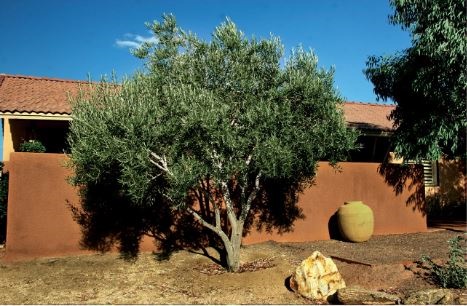
Plant Form: Tree
Water Use: Low
Mature Size: 20 – 30 ft. tall x 15 – 25 ft. wide
Exposure: Full sun, part sun
Bloom Time: Spring (March – May)
Hardiness: Cold Hardy to 15°F
Native to: Mediterranean Region
Olive trees have been cherished since the time of the Roman Empire for their picturesque gnarled trunks and branches. Over the millennia, people have enjoyed the tree’s edible olives (which must be cured in brine before eating), and the valuable olive oil pressed from their fruit. Gardeners today appreciate the tree’s tolerance of heat, poor soils, drought, very low water, and ease of care, as well as the soft gray foliage that complements most other colors. Some people; however, are allergic to the tree’s pollen, and some disdain the olives dropping on their patios, causing stains. Hybrid varieties are available that produce little or no pollen and no fruit (like ‘Swan Hill,’ ‘Majestic Beauty,’ and ‘Wilsonii’). Fruiting varieties can be sprayed with a fruit-control hormone during flowering, but this is a yearly program. On patios, decks, or around pools, fruitless varieties are recommended. Olive trees are magnificent as specimen trees, planted in mass, or in large containers. Dwarf varieties are available.
THIS MONTH IN YOUR DESERT-SMART LANDSCAPE
Frost is likely on dry, windless, clear nights this month.
- Keep plants watered to help prevent frost damage
- Wrap irrigation valves and pipes to protect from freezing